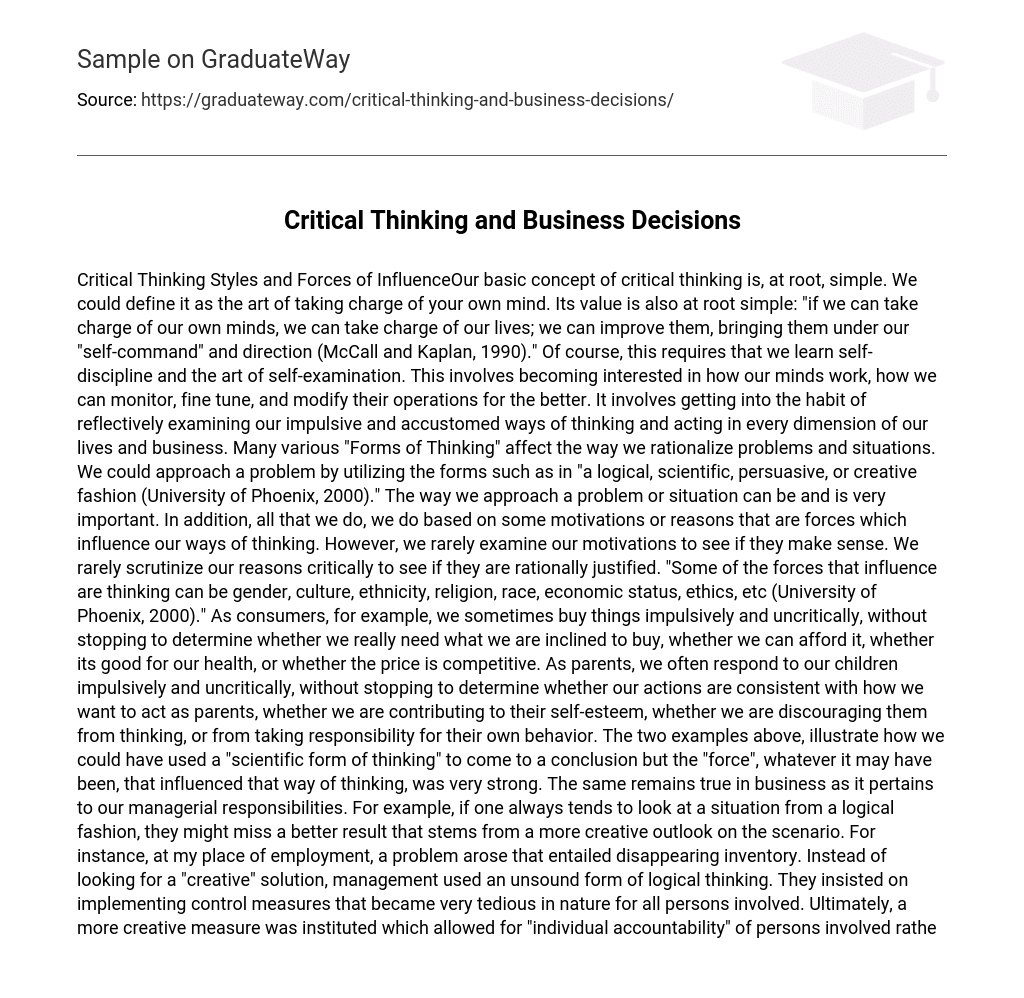Critical Thinking Styles and Forces of InfluenceOur basic concept of critical thinking is, at root, simple. We could define it as the art of taking charge of your own mind. Its value is also at root simple: “if we can take charge of our own minds, we can take charge of our lives; we can improve them, bringing them under our “self-command” and direction (McCall and Kaplan, 1990).” Of course, this requires that we learn self-discipline and the art of self-examination. This involves becoming interested in how our minds work, how we can monitor, fine tune, and modify their operations for the better. It involves getting into the habit of reflectively examining our impulsive and accustomed ways of thinking and acting in every dimension of our lives and business. Many various “Forms of Thinking” affect the way we rationalize problems and situations. We could approach a problem by utilizing the forms such as in “a logical, scientific, persuasive, or creative fashion (University of Phoenix, 2000).” The way we approach a problem or situation can be and is very important. In addition, all that we do, we do based on some motivations or reasons that are forces which influence our ways of thinking. However, we rarely examine our motivations to see if they make sense. We rarely scrutinize our reasons critically to see if they are rationally justified. “Some of the forces that influence are thinking can be gender, culture, ethnicity, religion, race, economic status, ethics, etc (University of Phoenix, 2000).” As consumers, for example, we sometimes buy things impulsively and uncritically, without stopping to determine whether we really need what we are inclined to buy, whether we can afford it, whether its good for our health, or whether the price is competitive. As parents, we often respond to our children impulsively and uncritically, without stopping to determine whether our actions are consistent with how we want to act as parents, whether we are contributing to their self-esteem, whether we are discouraging them from thinking, or from taking responsibility for their own behavior. The two examples above, illustrate how we could have used a “scientific form of thinking” to come to a conclusion but the “force”, whatever it may have been, that influenced that way of thinking, was very strong. The same remains true in business as it pertains to our managerial responsibilities. For example, if one always tends to look at a situation from a logical fashion, they might miss a better result that stems from a more creative outlook on the scenario. For instance, at my place of employment, a problem arose that entailed disappearing inventory. Instead of looking for a “creative” solution, management used an unsound form of logical thinking. They insisted on implementing control measures that became very tedious in nature for all persons involved. Ultimately, a more creative measure was instituted which allowed for “individual accountability” of persons involved rather than immediate accusations of a department as a whole. Many weeks of low employee morale, resulting in poor productivity could have been avoided by “brainstorming” creative measures rather then instituting what seemed like a logical and scientific measure. I can only speculate as to what “force of influ!ence” had an impact on the decision that was made. However, my opinion is that the Directors own “business culture” in a different industry, could have been to blame. In short, the Directors “perception” of the problem in the above example was not “reality”. The disappearing inventory was not the fault of procedural department documentation. In looking for a logical explanation and applying a logical solution, he overlooked a more simple and rational resolution to the true “reality” that existed. This reality was that individuals were not being held “accountable” for their actions or mistakes. How do we accept each other’s differences? It is quite possible, and unfortunately quite “natural”, to live an unexamined life, to live in a more or less automated, uncritical way. It is possible to live, in other words, without really taking charge of the persons, we are becoming, without developing, or acting upon, the skills and insights that we are capable of. However, if we allow ourselves to become unreflective persons, or rather, to the extent that we do, we are likely to do harm to ourselves and others, and to miss many opportunities to make our own lives, and the lives of others, fuller, happier, and more productive.
On this view, as you can see, critical thinking is an eminently practical goal and value. It is focused on an ancient Greek ideal of “living an examined life (Shermerhorn, Hunt, and Osborn, 2000).” It is based on the skills, the insights, and the values essential to that end. It is a way of going about living and learning that empowers our employees and us in quite practical ways. When taken seriously, it can transform every dimension of work life: how we formulate rules, how we relate to our employees, how we encourage them to relate to each other, how we cultivate their speaking and listening skills, as well as their decision making skills. Of course, we are likely to make “Critical Thinking” a basic value in work only insofar as we make it a basic value in our lives. “Therefore, to become adept at contemplating critical thinking, we must become committed to thinking critically and reflectively about our own lives and the lives of those around us (Shermerhorn, Hunt, and Osborn, 2000).” We must become active, daily, practitioners of critical thought. We must regularly model for our employees what it is to reflectively examine, critically assess, and effectively improve the way we live and think.
Bibliography:Morgan W. McCall Jr. and Robert E. Kaplan, (1990). “Whatever It Takes, Realities ofManagerial Decision Making,” (New Jersey: Prentice Hall)Schermerhorn, Hunt, and Osborn. (2000). Organizational Behavior. 7th Ed. New York:John Wiley ; Sons, Inc.
University of Phoenix, (2000). Critical Thinking: Strategies in Decision Making. (Module) MGT 350.





